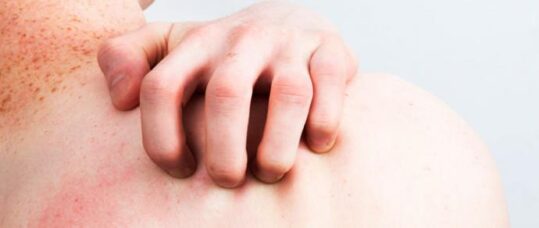Pruritus diagnosis and treatment

Causing an intense need to scratch, pruritus is described as an unpleasant sensation that has a large impact on patients’ quality of life. It is a common and distressing symptom of many dermatological, systemic and psychological disorders.1,2
Pruritus that may be acute (less than six weeks) or chronic (more than six weeks) is classified as:1
1. Pruritus with associated underlying dermatosis.
2. Pruritus with no underlying dermatosis:
Related Article: Diagnosis Connect service will link people to advice from charities
- Secondary pruritus due to underlying systemic disorder (secondary pruritus).
- Generalised pruritus of unknown origin.
Both types of pruritus with no underlying dermatosis may have secondary skin changes due to scratching and rubbing such as excoriations (scratches), lichenification (skin thickening) and nodular prurigo (itchy nodules or bumps).
Generalized pruritus without a rash can be caused by the following:1
- Pruritic skin diseases before rash.
- Disorders of iron metabolism.
- Uraemia.
- Hepatic disease (especially cholestasis).
- Malignancy.
- Haematological disorders.
- Infection.
- Endocrine disease.
- Neurological disorders.
- Psychological and emotional factors.
- Adverse drug reactions.
- Heart failure.
- Pregnancy.
- Pruritus of elderly skin.
- Generalised pruritus of unknown origin.
Diagnosis of pruritus can be challenging, especially for chronic pruritus and requires a structured and systematic approach to identify the underlying cause for the pruritus.1,2
Consultations for chronic pruritus should include the following:
- A detailed clinical history and physical examination looking for subtle skin changes. These may include dermographic urticaria (a red, raised rash along scratch marks), xerosis (dry skin), asteatotic eczema (a fine scale common in the elderly in winter), or scabies.3
- Identificaiton of the nature of the itch, including its location, onset, timing and duration. Also identify any relieving factors or associated symptoms such as contact with others who may have itch, drug and dietary history, history of alcohol misuse, and any emotional stress or mental health problems as all this will help to determine whether there is an underlying cause.4
- Appropriate investigations, directed from the initial clinical assessment.
- Referral and collaboration with other disciplines based on the history, examination and investigations.
Treatment
The management of pruritus will be dependent on the underlying cause and diagnosis. Symptomatic measures may be appropriate in patients where no cause can be identified or treated.
Related Article: CVD prevention must be national health priority, says report
More directed management can be divided into topical treatments, systemic treatments, phototherapy, psychological approaches or alternative therapies and should be based on the pruritus classifications cited within the latest guidance.1
Regardless of the underlying disease, symptom relief is most important to patients.2 Simple measures should be adopted initially such as: (see resources)
- Avoiding factors that may contribute to skin dryness such as overheating, hot baths, and soaps, shower and bath products.
- Using emollients for dry skin, including for washing, bathing and showering.
- Laying a cool flannel that has been soaked in an emollient cream on the skin or applying a cooled emollient that has been kept in the refrigerator.
- Patting the skin instead of scratching and keeping nails short.
- Using anti-itch creams containing a moisturiser and additional ingredients such as crotamiton, lauromacrogols, menthol and doxepin is possible. However, their use should be based on the classification as recent evidence does not support using these products for all types of pruritus.1
- Using topical corticosteroids if there is an in inflammatory skin condition.
- Taking antihistamines may help to improve some causes of pruritus. Both non-sedating antihistamines and sedating antihistamines (should be used with caution in the elderly) may be used.
Other interventions may include the use of behaviour modification including habit reversal training, phototherapy, the use of systemic medications, which include antidepressants such as tricyclic and SSRIs and anticonvulsants such as gabapentin and pregabalin.1
Although many treatment options are currently available, chronic pruritus remains a therapeutic challenge and often requires the use of combination therapies over a long period of time.
References
Related Article: Postnatal contraception advice reduces the risk of back-to-back pregnancies
- Millington GWM, Collins A, Lovell C, et al. British Association of Dermatologists’ guidelines for the investigation and management of generalized pruritus in adults without an underlying dermatosis, 2018. Br J Dermatol 2018;178:34-60
- Pereira MP, Kremer AE, Mettang T, Ständer S. Chronic Pruritus in the Absence of Skin Disease: Pathophysiology, Diagnosis and Treatment. Am J Clin Dermatol 2016;17:337-348
- Primary Care Dermatology Society. Pruritus (without a rash). Hertfordshire;PCDS:2017
- NICE. CKS: Itch – widespread. London;NICE:2015
Resources
- Guide to pruritus – Pruritus
- Patient information leaflet on pruritus – Pruritus (itching without a rash)
- Raising awareness of the psychosocial impact of skin disease – Psychodermatology UK

See how our symptom tool can help you make better sense of patient presentations
Click here to search a symptom


Pruritus is a common and distressing symptom of many dermatological, systemic and psychological disorders.



